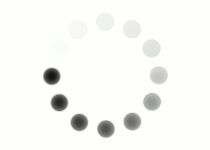The most noticeable feature of tessellations is repetition--the repeating of like shapes in a pattern on a two-dimensional plane, or flat surface. If you think about how a tessellation is created, you may imagine that somehow the shapes are copied, and the copy placed in precise relation to the original shape. The angles of the shapes and the length of the sides don't change--only the position and the orientation of each "copy" is different.
This approach to copying and placing images may seem familiar to you because of earlier lessons in this course. Remember transformations? The term transformation describes a procedure that preserves the shape and size of an object while changing its position or orientation. Transformations include translations, reflections, and rotations.
Use the slide show below to learn more about how tessellations are related to transformations.
|
Which transformation is needed to map the top left white square with the green pinwheel onto the bottom white square with the blue pinwheel? Translation. Translations involve sliding a shape left or right and/or up or down. The white square with the green pinwheel has been translated down and to the right.
Which two transformations map the left bolded pattern onto the right bolded pattern? A rotation and and translation. The bolded pattern has been turned (rotated) about its center to make it more vertically oriented and then shifted (translated) to the right.
What transformation can be used to map a row of blue triangles onto the row of green triangles below it? A reflection! A reflection is one of those transformations that changes orientation. Think of the dark bold line as a mirror or line of reflection. |
Question
Why do you need to know about transformations in order to create tessellations?
![By Jim [GFDL (http://www.gnu.org/copyleft/fdl.html) or CC-BY-3.0 (http://creativecommons.org/licenses/by/3.0)], via Wikimedia Commons](https://s3.amazonaws.com/cms.accelerate-ed.com/image/63a306ed-2339-4021-a5e5-cf1af0b2d7c7.jpg)

![Tiling Regular 3-6 Triangular by R. A. Nonenmacher ) [GFDL (http://www.gnu.org/copyleft/fdl.html) or CC-BY-3.0 (http://creativecommons.org/licenses/by/3.0)], via Wikimedia Commons](https://s3.amazonaws.com/cms.accelerate-ed.com/image/dd84a384-e43b-42fa-adbd-d31f870c4ab0.png)
